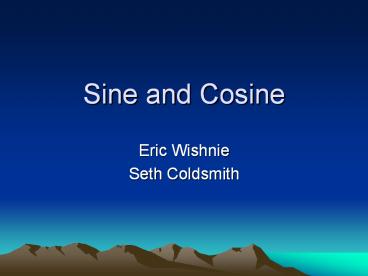Sine and Cosine PowerPoint PPT Presentation
Title: Sine and Cosine
1
Sine and Cosine
- Eric Wishnie
- Seth Coldsmith
2
What is sine?
- Without a calculator, determine the sine of the
central of the given circle with radius 2.5
inches.
3
The Greeks
- Hipparchus of Rhodes
- Modeling the night sky
- Chords over angles
- Circle, radius 3438, table of chords
- Claudius Ptolmey
- Almagest, proved basic theorems of chords
- Spherical triangles
- New table of chords
4
The Indians
- Half chords
- Half the chord of twice the angle sine of angle
- Table of half-chords
- Half-chord Rsin(a), R radius, a angle
5
Arab to European
- Additions to Indian mathematics
- Expansion on spherical triangles
- Shadow function tangent
- Mistranslation to European
- Arab words written without vowels
- The word jiba which was written jb was misread as
jaib. - Jaib means a cove or bay so this translated
to Sinus
6
Sinus
- This word was obviously created by a man.
- Why????
- Originally meant bosom.
- Later came to mean the fold of a garment at the
bosom (cleavage). - Also was applied to a cove or bay that took the
shape of the bosom. (If you dont believe us,
take a closer look at the picture on page 149 of
the book.) - Latin root of our word Sinuous from which sine
originated
7
Regiomontanus
- Real name was Johannes Muller
- Wrote On All Sorts of Triangles in 1463 but
wasnt published until decades later. - Only used Sine
- Used it as the length of a line segment and not
as a ratio as we know today - Computed a large table of sines to a circle with
a radius of 60,000 (known as the total sine)
from which these calculations were based upon.
8
Regiomontanus cont
- Occasionally needed to use the sine of the
complementary angle (cosine) - Wasnt originally recognized as cosine in the
form of its own name, quantity, or ratio - Went from sinus complimenti to co. sinus to
cosine in a century - Could be considered the Father of Trigonometry
9
Other Trig Contributions
- Joachim Rheticus (1514 1574 A.D. ) shows how to
define sine and cosine using a right triangle
without referencing a circle, - Thomas Fincke (1561 1656 A.D.) invented the
words tangent and secant - Bartholomeo Pitiscus (1561 1613 A.D) invented
the word trigonometry as part of the title to
his book. - Gilles de Roberval (1602 1675 A.D.) sketches
the sine curve while trying to find the area of a
cycloid.
10
Leonhard Euler
- Euler thinks of Sine as a function.
- Invented calculus and more specifically the use
of functions. - Shows sine to be a function of the measure of the
arc of an angle in the unit circle measured in
radians. - Makes the sine curve make sense.
11
Timeline
- 190 120 B.C. Hipparchus of Rhodes wants to
model the night sky and uses chords, angles, a
circle of radius 3438 to create his table of
chords. - 85 165 A.D. Claudius Ptolemy writes Almagest,
proved basic theorems of chords, used these to
create spherical triangles, and created a new
table of chords. - 400 499 A.D. First written evidence in India of
the use of half-chords. - 6th Century A.D. (Aryabhata) through the 12th
Century A.D. (Bhaskara) there are more and more
sophisitcated methods developed to approximate
the length of half-chords - 12th Century A.D. through the 15th Century A.D.
the Europeans get their hands on the Indian
manuscripts that describe the calculations of
half chords and after translating them they
further the development of the calculations of
half-chords.
12
Timeline Cont
- 1463 A.D. Johannes Muller (Regiomontanus) writes
On All Sorts of Triangles uses sine and cosine
even though he does not define them as we do
today. (Father of Trigonometry) - 15th Century A.D. trigonometry finally becomes an
object of interest outside of astrology. - 1514 1574 A.D. Joachim Rheticus defines sine
and cosine in term of right triangles. - 1561 1656 A.D. Thomas Fincke invented the words
tangent and secant. - 1561 1613 A.D. Bartholomeo Pitiscus invented
the word trigonometry. - 1602 1675 A.D. Gilles de Roberval sketched a
sine curve while computing the area of a cycloid. - 17th Century A.D. Trigonometry is used to solve
certain types of algebraic problems. - 1707 1783 A.D. Leonhard Euler introduced sine
as a function of the unit circle.
13
References
- Berlinghoff, William. Gouvea, Fernando. A Gentle
History for Teachers and Others. Farmington,
Maine Oxton House Publishers 2002. - Katz, Victor J. A History of Mathematics Brief
Edition. New York, New York. Pearson/Wesley 2004. - NCTM 31st Yearbook. Historical Topics for the
Mathematics Classroom The History of
Trigonometry. Washington D.C. NCTM 1969.

